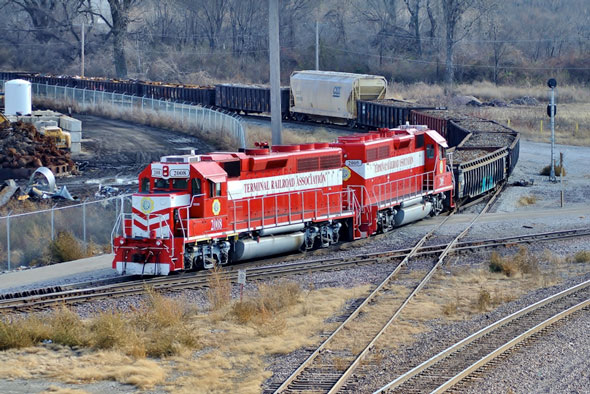
The FRA announced a further proposed delay to the implementation of new safety program rules for the nation’s railroads. The move is in response to small railroad operators that contend they need more time to implement the change. A Terminal Railroad of St. Louis freight train is seen at work in Venice, Illinois in November of 2014. Image © 11/2014 by Nikki Burgess; all rights reserved.
Holiday greetings! Hopefully everyone enjoyed their day. Normally, the period between Christmas and the New Year is very quiet; this year, we have a new IATA Corrigendum to consider! See the details below as well as the rest of the week’s news—and have a safe and happy New Year’s Day celebration:
IATA Corrigendum to the 59th Edition
In just a week’s time, IATA will begin to use its 59th edition of the Dangerous Goods Regulations—the go-to set of rules for shipping by air all over the world. A corrigendum to the regulations was issued on the 22nd of December, modifying what will appear in the new book. Here are a few key points:
- IATA returns to the images for several of the various handling labels that were used in the 58th edition rather than the modified images seen in the 59th edition’s book. The exception is the lithium battery handling label, which was not reissued. The red cross-hatching on that label’s borders is somewhat different in the image seen in the 59th edition and this corrigendum did not return to the earlier version seen in the 58th IATA has made informal statements that there is no intent to have made any official change to the label’s specifications between the 58th and 59th editions and that the altered appearance of the hatching is inconsequential.
- A variety of airline variations have been changed or newly issued. One variation of particular interest to the US audience may be that in UPS 5X-02, which restricts certain goods to combination packages only and prohibits the use of single packages when considering transport aboard passenger aircraft. Users should review this change carefully.
- A clarification has been made as to how and where information about excepted quantities of dangerous goods are to be recorded on air waybills.
- Section 2.3 dealing with dangerous goods carried or checked by passenger’s sees significant change account—you guessed it—more restrictions on lithium batteries.
- A variety of other relatively minor changes round out the corrigendum.
See the new corrigendum for yourself right here:
DGR59-Addendum1-EN-22 December 2017
FRA
The nation’s rail safety agency published a proposal to further delay compliance with the 2014-issued regulations regarding establishing the requirement for formal safety programs at many railroads not previously covered under such rules, or that were not required to have such extensive programs as the new regulations require. The proposed delay adds another year to the window to comply with the various provisions and was issued on the behest of short line (i.e. small) railroad operators, many of whom lack the institutional expertise to create and manage such programs and are consequently behind the compliance curve. See the proposed delay here:
https://www.gpo.gov/fdsys/pkg/FR-2017-12-20/pdf/2017-27272.pdf
USDOT
The department announced the availability of its report outlining the ways in which it intends to reduce the regulatory burden on its impacted industry segments in accordance with the Trump Administration’s directive shortly after taking office that all federal regulating agencies do so. See DOT’s plan right here:
https://www.gpo.gov/fdsys/pkg/FR-2017-12-22/pdf/2017-27654.pdf
Labelmaster is a full service provider of products, shipping software, and professional consulting services to assist the DG and HS&E professional to comply with national and international regulations. See our full line of solutions at www.labelmaster.com.


